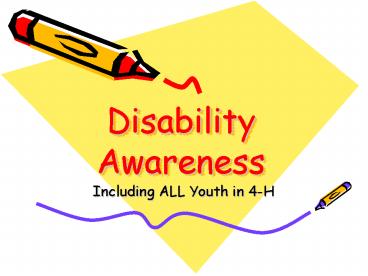Disability Awareness - PowerPoint PPT Presentation
1 / 31
Title:
Disability Awareness
Description:
Our unified worldview, beliefs and values informed from an inside perspective of ... disabilities include Albert Einstein, Cher, Bruce Jenner, James Earl Jones ... – PowerPoint PPT presentation
Number of Views:2846
Avg rating:3.0/5.0
Title: Disability Awareness
1
Disability Awareness
- Including ALL Youth in 4-H
2
Images of Disability
3
Images of Disability
4
Images of Disability
5
Images of Disability
6
Core Principles
- Acceptance of human difference
- Tolerance
- Patience
- Ability to accept a lack of resolution
7
Core Principles
- Our unified worldview, beliefs and values
informed from an inside perspective of lived
experiences and daily successes - Seeing With
- Being aware on a daily basis
8
Dimensions of Disability
- Everyone one of us is different
- By chance
- By choice
- Everybody reacts to differences
- Attract
- Surprise
- Frighten
- Some are not important to us
9
We ALL Evaluate Differences
- First reactions are automatic reflexes wired into
our brains - What we do after our first reaction, however, is
based on experience, learning and choices
10
Attitudesare the REALDisability
11
Attitudinal Barriers
- Inferiority
- Pity
- Hero worship
- Stereotypes
- Denial
- Fear
12
Disability vs. Handicap
- Disability is the preferred term to describe
physical, cognitive, and developmental
limitations due to impairment. - Handicap refers to external situations. The lack
of a ram that creates an obstacle that results in
limitation.
13
FACTOIDThe term handicap originated from the
phrase hand-in-cap referring to people with
disabilities who begged for money on the street.
This was long before there were public programs
to offer assistance and support.
14
Language IS important
- Use person first language
- one is a person before one is disabled
- A person with a disability.
- Avoid old stereotypes
- Avoid terms such as handicapped, cripple,
afflicted, victim, special, invalid, suffers from
15
More facts
- Only 15 of disabilities are present at birth
- 85 are acquired later
- 32 of the US population has a disability
- 1 in 8 children has a disability
- 51 are learning disabilities
- Over 12 million people have asthma, the leading
cause of absenteeism at school work
16
Some common types of disabilities
- Visual
- Hearing
- Learning
- Cognitive
- Non-visible
- Developmental
- Environmental
- Physical
- Systemic
- Psychiatric
- Multiple
17
Non-visible disability
- Many disabilities are not visible
- Learning disabilitis make up the majority of new
disability diagnoses - Notable people with non-visible disabilities
include Albert Einstein, Cher, Bruce Jenner,
James Earl Jones
18
Disability Etiquette
19
Blindness Visual Impairment
- Identify yourself when you enter a room
- Offer your elbow when walking
- Dont treat service animals as pets
- Speak directly to the individual
20
Deaf and Hard-of-Hearing
- Get the persons attention before speaking to
him/her - Ask what is the preferred method of communication
- Be creative when sharing detailed information
- Understand that not everybody reads lips
21
Deaf and Hard-of-Hearing
- Ask to repeat if you do not understand
- Be sure that you get your point across
- Be aware of the environment
- Sign language is not universal. There are many
regional sign languages.
22
Learning Disabilities
- Learning disabilities are common
- A learning disability is a non-visible disability
- There is no connection between a persons
intelligence and a learning disability - A learning disability is in information
processing, storage or retrieval difference
23
Some common learning disabilities (LD) may cause
- Challenges with reading
- Challenges with writing
- Challenges with listening
24
Physical Disabilities
- A physical disability may
- Include orthopedic, neuromuscular, cardiovascular
and pulmonary disorders - Be congenital or the result of injury or
progressive disease - People with disabilities often rely upon
assistive devices
25
Physical Disabilities
- Use common language
- Using words like running and walking are
appropriate - Avoid confining language
- Such as confined to a wheelchair or
wheelchair-bound - Instead use terms such as uses a wheelchair or
wheelchair user - A wheelchair in reality increases access and
mobility
26
Physical Disabilities
- Respect private property
- Avoid moving canes, crutches, walkers, etc.
unless asked to do so - Wheelchairs should be considered personal space
- Service animals should not be treated as pets
27
Be respectful
- Public Disability Accommodations
- Parking spaces
- Curb cuts
- Special seating on buses or in theatres
28
A few more guidelines
- Speak directly to the individual
- Treat disabled adults as you would any other
adult - Dont focus on the disability
- Speak with a normal tone of voice
- Offer to shake hands
- Dont exclude people with disabilities from
activities
29
If you are not sure, ask
- A person with a disability would much rather be
asked questions about what the appropriate
protocol is rather than be caught in an
uncomfortable situation.
30
It is okay if you make a mistake
- When a mistake is made, just apologize and
correct the problem, learn from the mistake and
move on. Sincerity is the key to a positive
interaction with anyone.
31
We are all human































